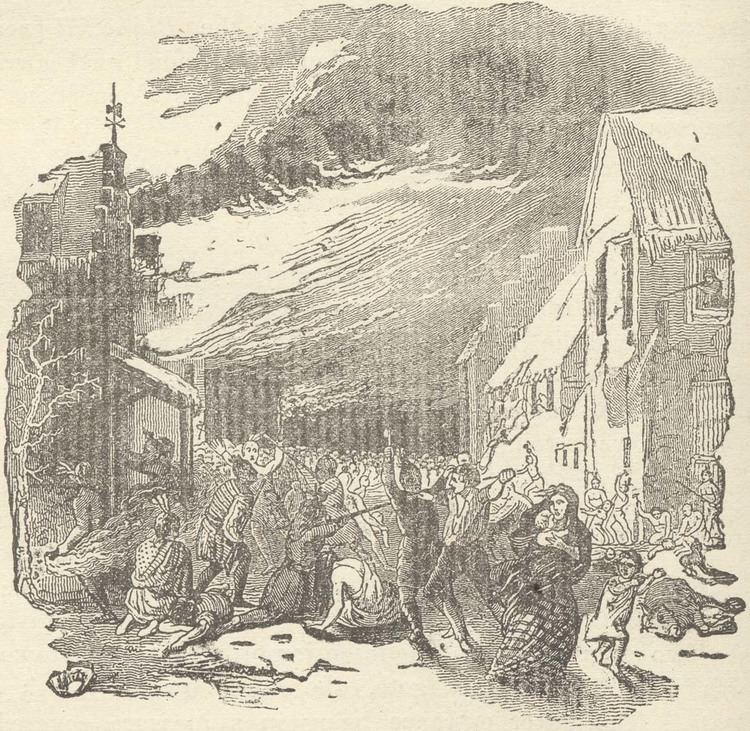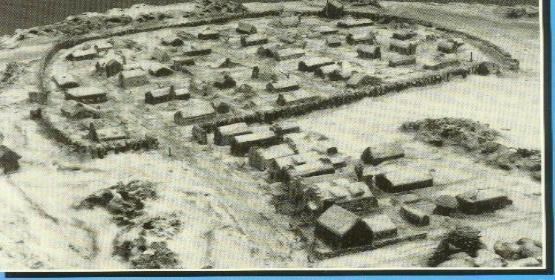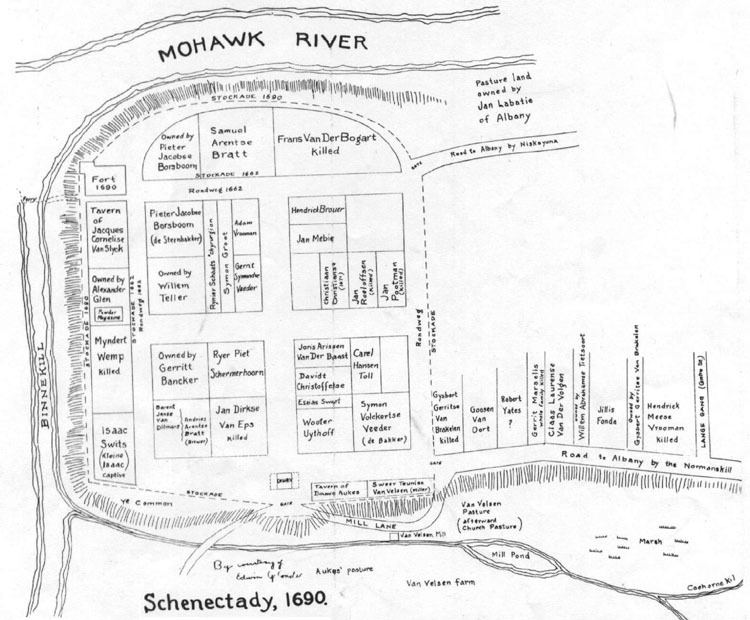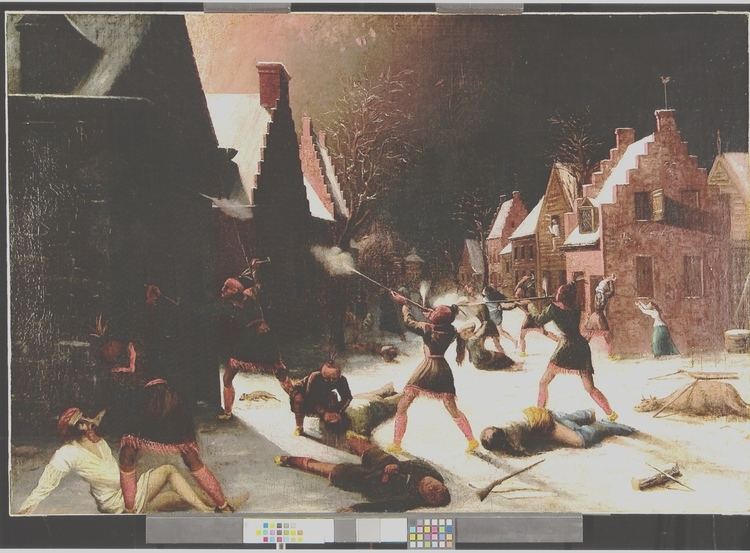Start date 1690 | ||
 | ||
Similar Lachine massacre, Raid on Deerfield, Raid on Salmon Falls, Hudson Bay expedition, Siege of Pemaquid | ||
The Schenectady Massacre was a Canadian attack against the village of Schenectady in the colony of New York on 8 February 1690. A party of more than 200 Canadians and allied Mohawk, Sault (Ojibwe), and Algonquin warriors attacked the unguarded community, destroying most of the homes, and killing or capturing most of its inhabitants. Sixty residents were killed, including 11 enslaved Africans. About 60 residents were spared, including 20 Mohawk.
Contents

Of the non-Mohawk survivors, 27 were taken captive, including 5 Africans. Three captives were later redeemed; another two men returned to the village after three and 11 years with the Mohawk, respectively. The remainder of the surviving captives were likely adopted by Mohawk families in Canada.

The French raid was in retaliation for the Lachine massacre, an attack by Iroquois forces on a village in Quebec. These skirmishes were related both to the Beaver Wars and the French struggle with the English for control of the fur trade in North America, as well as to King William's War between France and England. By this time, the French considered most of the Iroquois to be allied with the English in their New York colony, and hoped to detach them while reducing English colonial power.

Background

In much of the late 17th century, the Iroquois and the colonists of New France engaged in a protracted struggle for control of the economically important fur trade in northern North America, known as the Beaver Wars. The Iroquois also fought other Native American nations to control the lucrative trade with the French. In August 1689, the Iroquois launched one of their most devastating raids against the French frontier community of Lachine. This attack occurred after France and England declared war on each other, but before the news reached North America.
New France's governor the Comte de Frontenac organized an expedition from Montreal to attack English outposts to the south, as punishment for English support of the Iroquois, and as a general widening of the war against the northernmost English colonies. He intended to intimidate the Iroquois and try to detach them from trading with the English.
The expedition was one of three directed at isolated northern and western settlements, and this was originally directed against Fort Orange (present day Albany). It consisted of 114 French Canadians, mostly frontier-savvy coureurs de bois, 80 Sault and 16 Algonquin warriors, with a few converted Mohawk. They marched the 200 miles overland in about 22 days. Taking Fort Orange would have been a major blow against the English. At what is now Fort Edward, the French officers held council on the plan of attack.
The leaders were Jacques Le Moyne de Sainte-Hélène and Nicolas d'Ailleboust de Manthet; the second in command was Pierre Le Moyne d'Iberville, who founded Louisiana in 1699. The expedition made its way across the ice of Lake Champlain and Lake George toward the English communities on the Hudson River. They found Fort Orange to be well defended, but a scouting party reported on February 8 that no one was guarding the stockade at the small frontier village of Schenectady to the west. Its residents were primarily ethnic Dutch and they held numerous African slaves. Schenectady and Albany were so politically polarized in the wake of the 1689 Leisler's Rebellion that the opposing factions had not agreed on the setting of guards in the two communities.
The village of Schenectady (its name came from a Mohawk word meaning "beyond the Pines") was located on a patent to farm on the Great Flats of the Mohawk River originally granted by the Dutch in 1661. It was located about seven miles beyond the western border of Rensselaerswyck.
Attack
Finding no sentinels other than two snowmen and the gate ajar according to the tradition, the raiders silently entered Schenectady two hours before dawn and launched their attack. They burned houses and barns, and killed men, women and children. Most of the victims were in night clothing and had no time to arm themselves.
By the morning of February 9, the community lay in ruins - more than 60 buildings were burned. Sixty residents were killed, including 11 African slaves (referred to as negroes in records). The French noted that about 50-60 residents survived and that they had spared 20 Mohawk, so the Native people would know their targets were the English settlements, not the Mohawk.
The 60 dead included 38 men, 10 women and 12 children. Among them were Dominie Petrus Tessemacher, the first Dutch Reformed Church pastor to be ordained in the new world, and pastor of what became the First Reformed Church of Schenectady. The French had intended to take him captive in order to question him, but he was killed in his house. Reynier Schaets and a son were among the dead. Schaets was a son of Gideon Schaets, dominie of the Dutch Reformed Church at Albany. He was a surgeon, who had been appointed Justice at Schenectady by Governor Leisler on December 28, 1689. His wife Catharina Bensing and three other children: Gideon, Bartholomew and Agnietje, survived.
Of those who escaped from the burning stockade area to seek shelter with families some miles distant, many died of exposure in the bitter cold before they reached safety.
The raiders departed with 27 prisoners, including five Africans; and 50 horses.
John A. Glen, who lived in Scotia, across the river from Schenectady, had shown previous kindness to the French. In gratitude, the raiding party took the Schenectady prisoners to him, inviting him to claim any relatives. Glen claimed as many survivors as he could, and the raiders took the rest to Montreal. Typically those captives who were too young or old or ill to keep up along such an arduous 200-mile journey were killed during the way. As was the pattern in later raids in New York and New England, many of the younger captives were adopted by Mohawk families in Canada.
Some survivors had fled as refugees to the fort at Albany. Symon Schermerhorn was one of these. Although wounded, he rode to Albany to warn them of the massacre. In commemoration of this, the mayor of Schenectady repeats the ride every year. Most mayors have done so on horseback, though a few have preferred the comfort of an automobile.
A party of Albany militia and Mohawk warriors pursued the northern invaders. They killed or captured 15 or more almost within sight of Montreal.
Of the surviving captives, three males were redeemed: Johannes Teller and brothers Albert and Johannes Vedder. Jan Baptist Van Eps escaped from the Mohawk after three years and returned to Schenectady. Lawrence Vander Volgen lived with the Mohawk for 11 years and then returned; he served as Provincial interpreter.
Aftermath
The attack forced New York's political factions to put aside their differences and focus on the common enemy of New France. As a result of the attack, the Albany Convention, which had until then resisted Jacob Leisler's assumption of power in the southern parts of the colony, acknowledged his authority. With the assistance of Connecticut officials, Leisler organized a retaliatory expedition the next summer from Albany to attack Montreal. Led by Connecticut militia general Fitz-John Winthrop, the expedition turned back in August 1689 due to disease, lack of supplies, and insufficient watercraft for navigating on Lake Champlain.
Representation in culture
In 1990, the city of Schenectady commissioned composer Maria Riccio Bryce to create a musical work to commemorate the tricentennial of the massacre. The resulting piece, Hearts of Fire, followed the lives of Schenectady townspeople through the seasons of 1689, set against the backdrop of the French march from Montreal to Albany. Though the settlers' losses were great in deaths and also captives taken, they elected to stay and rebuild, honoring the memory of their relatives.
